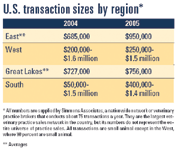Will mergers boost revenues?
About 45 to 55 percent of a doctor's time can be spent performing non-clinical duties.
NATIONAL REPORT — Private practitioners are starting to consolidate operations with would-be competitors, according to practice brokers.
As consultants continue to tout the benefits of uniting under one roof to mitigate overhead and ultimately bolster revenues, the idea is starting to take hold in some parts of the country.
"I'm seeing more mergers and more true acquisitions, where one might buy another practice and bring it under one roof, and sometimes retaining just one owner," says Byron Farquer, DVM, director of Simmons and Associates Southwest and Pacific territories. "That process has been extremely successful in the corporate world for years. And it's being embraced now with veterinarians, and even the discussion of it has bubbled to the surface during the past three or four years."

U.S. transaction sizes by region*
Managing the infrastructure of a practice, including customer service, managing employees, procurement, inventory and balancing the books, often takes a big cut out of a practitioner's useful day. If two, separate one-doctor practices are each responsible for these duties, then there is a lost full-time practitioner in there somewhere, Farquer says.
"If we take a look at the one-doctor practice, studies have shown that anywhere from 45 to 55 percent of that doctor's time is spent doing non-clinical items, such as management and customer service," he says. When we get rid of some of the duplicity of management when we do mergers, we bring people together with reserve capacity. That's where our delivery system for veterinary medicine needs to change. It yields a significant savings, and where there is savings, there is profit."
National corporate consolidators have seen the viability in this model for years and continue to grow viable businesses because the corporate structure alleviates much of management duties for practitioners, says David B. Gerber, DVM, director of Simmons & Associates Northwest and trustee for the Simmons & Associates Educational Fund.
"There is just starting to be a lot of interest in the acquisition/merger model," he says.
But mergers might not be as easy as partnering with the practice down the street. A mere merger under one roof can be difficult to swallow for some practice owners who seldom needed to justify their decisions when they were a solo practitioner.
"Veterinarians have been plagued with doing the old merger model, where two Type-A personalities become partners, which is not always a recipe for success," Farquer says. "They do not always get along, and those who did not get help putting a merger together and make sure that they were compatible and had good management agreements, etc., didn't go very well. It kind of put a bad taste in everybody's mouth because you always hear the bad stories the loudest.
"The new model that is effective is the coming together of one or more practices at one address. It may or may not include multiple ownership of that practice," he says.
Although the new model might be getting some legs, many brokers say the new model is gaining acceptance slowly.
"There are strong advocates, and we've done a couple, but at this point, we still see mostly doctors buying out doctors," says Kurt D. Liljeberg, DVM, proprietor of Superior Business Brokerage, a member of the Veterinary Practice Sales Group, a national cooperative of independent brokers.
VPSG President Fred Zydeck, DVM, says it's been the same old model for several years in his northern Midwest territory.
"The practices I have been involved with have been traditional models, and the average sale for me is interested in going it alone," Zydeck says.
But one trend seen by all the brokers that spoke with DVM Newsmagazine was the increase in buying a portion of a practice. In today's market of competition for associate veterinarians, many owners are giving up a piece of their pie to retain productive practitioners who work well together.
"We're seeing increasing buy-ins because if an owner has a pretty good employee, if they don't bring them in and make them partner, then they might lose them," Liljeberg says.
Market conditions
By and large, sources say the real-estate and subsequently the practice sales business remains healthy. Interest rates are relatively low, and "buyers can still get a practice loan at about 8.5 percent," Liljeberg says.
There is plenty of 100-percent financing out there, too. Gerber says that's a pretty crucial component.
"Most of our buyers have been out of school for three to 10 years and have no money, and when I say no money I mean no money," he says. "I had a call last week from a woman, and I asked about her credit. She said her credit was great, but she has $500 in the bank."
Although many lenders do require a down payment, the seller, oftentimes, makes that payment for the buyer so cash-strapped entrepreneurs can essentially finance 100-percent of the purchase price.
"We try to do 100-percent financing about 80 percent of the time," says Daniel Croft, senior vice president of practice acquisitions for Unicyn Financial Cos. "You must have good credit and good cash flow, but we see a lot of people who are capable."
Unicyn entered the veterinary niche in 2004 after 25 years of lending to predominantly dental practices; 2005 was the first full year in the veterinary market, where the company doled out about $5 million. Croft says his typical deal lends about $400,000.
"Financing is readily available for most people looking for it. Rates are still low, and there are typically six to eight lenders they can get the money from on a regular basis," Croft says.